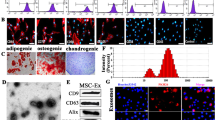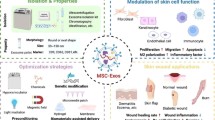Abstract
Triticum aestivum plant extracts are often used as a natural healer in traditional medicine but which particles mainly have role in these processes are not scientifically proven. In other words, no attempts have been made to investigate the effects of wheat exosomes in regenerative medicine applications or drug development up to now. The current study was first time performed to demonstrate the activity of wheat exosomes in wound healing process using in vitro approaches. Although its fundamental wound healing process remains a mystery, in the current study, the efficiency of wheat grass juice–derived exosomes on cell viability and migration was examined. Increasing concentrations up to 200 μg/mL of the wheat exosome have yielded astonishing proliferative and migratory effects on endothelial, epithelial, and dermal fibroblast cells. RT-PCR analysis also showed collagen type I; mRNA levels were approximately twofold higher in expression after treating with 200 μg/mL wheat exosome. Additionally, Annexin V staining of apoptotic cells accompanied with the cell cycle analysis resulted with the reduction of the apoptotic cell number with no dispersion to the cell cycle analysis while plant exosomes have also increased tube-like structure formation of the endothelial cells. All in all, this research suggests a brand-new opening for skin wound healing therapy strategy by using wheat-derived exosomes due to its proliferative and migratory characteristics. Plant exosomes require a further research both clinically and in in vivo for wound healing drug development. Moreover, plant exosome therapy strategies would be safer and economical alternative for clinical wound healing.






Similar content being viewed by others
References
Yates, C. C., Hebda, P., & Wells, A. (2012). Skin wound healing and scarring: fetal wounds and regenerative restitution. Birth Defects Research Part C - Embryo Today: Reviews, 96(4), 325–333. https://doi.org/10.1002/bdrc.21024.
Balekar, N., Katkam, N. G., Nakpheng, T., Jehtae, K., & Srichana, T. (2012). Evaluation of the wound healing potential of Wedelia trilobata (L.) leaves. Journal of Ethnopharmacology, 141(3), 817–824. https://doi.org/10.1016/j.jep.2012.03.019.
Corrado, C., Raimondo, S., Chiesi, A., Ciccia, F., De Leo, G., & Alessandro, R. (2013). Exosomes as intercellular signaling organelles involved in health and disease: basic science and clinical applications. International Journal of Molecular Sciences, 14(3), 5338–5366. https://doi.org/10.3390/ijms14035338.
Simons, M., & Raposo, G. (2009). Exosomes--vesicular carriers for intercellular communication. Current Opinion in Cell Biology, 21(4), 575–581. https://doi.org/10.1016/j.ceb.2009.03.007.
Zech, D., Rana, S., Büchler, M. W., & Zöller, M. (2012). Tumor-exosomes and leukocyte activation: an ambivalent crosstalk. Cell Communication and Signaling, 10(1), 37. https://doi.org/10.1186/1478-811X-10-37.
Théry, C., Regnault, A., Garin, J., Wolfers, J., Zitvogel, L., Ricciardi-Castagnoli, P., Raposo, G., & Amigorena, S. (1999). Molecular characterization of dendritic cell-derived exosomes. The Journal of Cell Biology, 147(3), 599–610. https://doi.org/10.1083/jcb.147.3.599.
Lai, R. C., Arslan, F., Lee, M. M., Sze, S. K., Choo, A., Chen, T. S., Salto-Tellez, M., Timmers, L., Lee, C. N., el Oakley, R. M., Pasterkamp, G., de Kleijn, D. P. V., & Lim, S. K. (2010). Addendum to exosome secreted by MSC reduces myocardial ischemia/reperfusion injury [Stem Cell Research, 4, (2010), 214-222]. Stem Cell Research, 5(2), 170–171. https://doi.org/10.1016/j.scr.2010.05.003.
Mallegol, J., Van Niel, G., Lebreton, C., Lepelletier, Y., Candalh, C., Dugave, C., et al. (2007). T84-intestinal epithelial exosomes bear MHC class II/peptide complexes potentiating antigen presentation by dendritic cells. Gastroenterology, 132(5), 1866–1876. https://doi.org/10.1053/j.gastro.2007.02.043.
Kapsogeorgou, E. K., Abu-Helu, R. F., Moutsopoulos, H. M., & Manoussakis, M. N. (2005). Salivary gland epithelial cell exosomes: a source of autoantigenic ribonucleoproteins. Arthritis and Rheumatism, 52(5), 1517–1521. https://doi.org/10.1002/art.21005.
Ristorcelli, E., Beraud, E., Verrando, P., Villard, C., Lafitte, D., Sbarra, V., et al. (2008). Human tumor nanoparticles induce apoptosis of pancreatic cancer cells. The FASEB Journal, 22(9), 3358–3369. https://doi.org/10.1096/fj.07-102855.
Lin, J., Li, J., Huang, B., Liu, J., Chen, X., Chen, X.-M., Xu, Y. M., Huang, L. F., & Wang, X.-Z. (2015). Exosomes: novel biomarkers for clinical diagnosis. The Scientific World Journal, 2015, 1–8. https://doi.org/10.1155/2015/657086.
Raimondo, S., Naselli, F., Fontana, S., Monteleone, F., Lo Dico, A., Saieva, L., et al. (2015). Citrus limon-derived nanovesicles inhibit cancer cell proliferation and suppress CML xenograft growth by inducing TRAIL-mediated cell death. Oncotarget, 6(23), 19514–19527. https://doi.org/10.18632/oncotarget.4004.
Allmang, C., Kufel, J., Chanfreau, G., Mitchell, P., Petfalski, E., & Tollervey, D. (1999). Functions of the exosome in rRNA, snoRNA and snRNA synthesis. EMBO Journal, 18(19), 5399–5410. https://doi.org/10.1093/emboj/18.19.5399.
Vashisht, M., Rani, P., Onteru, S. K., & Singh, D. (2017). Curcumin encapsulated in milk exosomes resists human digestion and possesses enhanced intestinal permeability in vitro. Applied Biochemistry and Biotechnology, 183(3), 993–1007. https://doi.org/10.1007/s12010-017-2478-4.
Saman, S., Kim, W. H., Raya, M., Visnick, Y., Miro, S., Saman, S., Jackson, B., McKee, A. C., Alvarez, V. E., Lee, N. C. Y., & Hall, G. F. (2012). Exosome-associated tau is secreted in tauopathy models and is selectively phosphorylated in cerebrospinal fluid in early Alzheimer disease. Journal of Biological Chemistry, 287(6), 3842–3849. https://doi.org/10.1074/jbc.M111.277061.
Peinado, H., Alecˇković, M., Lavotshkin, S., Matei, I., Costa-Silva, B., Moreno-Bueno, G., et al. (2016). Corrigendum: melanoma exosomes educate bone marrow progenitor cells toward a pro-metastatic phenotype through MET. Nature Medicine, 22(12), 1502–1502. https://doi.org/10.1038/nm1216-1502b.
Kim, M. S., Haney, M. J., Zhao, Y., Mahajan, V., Deygen, I., Klyachko, N. L., Inskoe, E., Piroyan, A., Sokolsky, M., Okolie, O., Hingtgen, S. D., Kabanov, A. V., & Batrakova, E. V. (2016). Development of exosome-encapsulated paclitaxel to overcome MDR in cancer cells. Nanomedicine: Nanotechnology, Biology, and Medicine, 12(3), 655–664. https://doi.org/10.1016/j.nano.2015.10.012.
Tan, C., Lai, R., Wong, W., Dan, Y., Lim, S.-K., & Ho, H. (2014). Mesenchymal stem cell-derived exosomes promote hepatic regeneration in drug-induced liver injury models. Stem Cell Research & Therapy, 5(3), 76. https://doi.org/10.1186/scrt465.
An, Q., Hückelhoven, R., Kogel, K. H., & van Bel, A. J. E. (2006). Multivesicular bodies participate in a cell wall-associated defence response in barley leaves attacked by the pathogenic powdery mildew fungus. Cellular Microbiology, 8(6), 1009–1019. https://doi.org/10.1111/j.1462-5822.2006.00683.x.
An, Q., van Bel, A. J., & Hückelhoven, R. (2007). Do plant cells secrete exosomes derived from multivesicular bodies? Plant Signaling & Behavior, 2(1), 4–7. https://doi.org/10.4161/psb.2.1.3596.
Mu, J., Zhuang, X., Wang, Q., Jiang, H., Deng, Z. Bin, Wang, B., … Zhang, H. G. (2014). Interspecies communication between plant and mouse gut host cells through edible plant derived exosome-like nanoparticles. Molecular Nutrition and Food Research, 58(7), 1561–1573. https://doi.org/10.1002/mnfr.201300729.
Ju, S., Mu, J., Dokland, T., Zhuang, X., Wang, Q., Jiang, H., … Zhang, H.-G. (2013). Grape exosome-like nanoparticles induce intestinal stem cells and protect mice from DSS-induced colitis. Molecular Therapy, 21(7), 1345–1357. https://doi.org/10.1038/mt.2013.64.
Mohan, A., Nair, S. V., & Lakshmanan, V. K. (2017). Leucas aspera nanomedicine shows superior toxicity and cell migration retarded in prostate cancer cells. Applied Biochemistry and Biotechnology, 181(4), 1388–1400. https://doi.org/10.1007/s12010-016-2291-5.
Singh, N., Verma, P., & Pandey, B. R. (2012). Therapeutic potential of organic Triticum aestivum Linn. (wheat grass) in prevention and treatment of chronic diseases: an overview. International Journal of Pharmaceutical Sciences and Drug Research, 4(1), 10–14 Retrieved from www.ijpsdr.com.
Ann Wigmore. (1985). The wheatgrass book. Avery.
Chauhan, M. (2014). A pilot study on wheat grass juice for its phytochemical, nutritional and therapeutic potential on chronic diseases. International Journal of Chemical Studies, 2(4), 27–34.
Koçak, P., Canikyan, S., Batukan, M., Attar, R., Şahin, F., & Telci, D. (2016). Comparison of enzymatic and nonenzymatic isolation methods for endometrial stem cells. Turkish Journal of Biology, 40(5), 1081–1089. https://doi.org/10.3906/biy-1508-56.
Reyes, A., Kazak, L., Wood, S. R., Yasukawa, T., Jacobs, H. T., & Holt, I. J. (2013). Mitochondrial DNA replication proceeds via a ‘bootlace’ mechanism involving the incorporation of processed transcripts. Nucleic Acids Research, 41(11), 5837–5850. https://doi.org/10.1093/nar/gkt196.
Wang, Q., Zhuang, X., Mu, J., Deng, Z.-B., Jiang, H., Zhang, L., et al. (2013). Delivery of therapeutic agents by nanoparticles made of grapefruit-derived lipids. Nature Communications, 4(May), 1867. https://doi.org/10.1038/ncomms2886.
Ju, S., Mu, J., Dokland, T., Zhuang, X., Wang, Q., Jiang, H., et al. (2013). Grape exosome-like nanoparticles induce intestinal stem cells and protect mice from DSS-induced colitis. Molecular Therapy, 21(7), 1345–1357. https://doi.org/10.1038/mt.2013.64.
Wang, B., Zhuang, X., Deng, Z.-B., Jiang, H., Mu, J., Wang, Q., Xiang, X., Guo, H., Zhang, L., Dryden, G., Yan, J., Miller, D., & Zhang, H.-G. (2014). Targeted drug delivery to intestinal macrophages by bioactive nanovesicles released from grapefruit. Molecular Therapy, 22(3), 522–534. https://doi.org/10.1038/mt.2013.190.
Wang, B., Zhuang, X., Deng, Z.-B., Jiang, H., Mu, J., Wang, Q., Xiang, X., Guo, H., Zhang, L., Dryden, G., Yan, J., Miller, D., & Zhang, H.-G. (2014). Targeted drug delivery to intestinal macrophages by bioactive nanovesicles released from grapefruit. Molecular therapy : the journal of the American Society of Gene Therapy, 22(3), 522–534. https://doi.org/10.1038/mt.2013.190.
Lauffenburger, D. A., & Horwitz, A. F. (1996). Cell migration: a physically integrated molecular process. Cell, 84(3), 359–369. https://doi.org/10.1016/S0092-8674(00)81280-5.
Martin, P., & Martin, P. (2016). Wound healing aiming for perfect skin. Regeneration, 276(5309), 75–81.
Weng, L., Brown, J., & Eng, C. (2001). PTEN induces apoptosis and cell cycle arrest through phosphoinositol-3-kinase/Akt-dependent and -independent pathways. Human molecular genetics., 10(3), 237–242. https://doi.org/10.1093/hmg/10.3.237.
Demirci, S., Doğan, A., Demirci, Y., & Şahin, F. (2014). In vitro wound healing activity of methanol extract of Verbascum speciosum. International Journal of Applied Research in Natural Products, 7(3), 37–44. https://doi.org/10.1155/2013/963457.
Kim, M. R., Lee, H. S., Choi, H. S., Kim, S. Y., Park, Y., & Suh, H. J. (2014). Protective effects of ginseng leaf extract using enzymatic extraction against oxidative damage of UVA-irradiated human keratinocytes. Applied Biochemistry and Biotechnology, 173(4), 933–945. https://doi.org/10.1007/s12010-014-0886-2.
Acknowledgements
We would like to thank Dr. Pakize Neslihan Taşlı for her help.
Author information
Authors and Affiliations
Corresponding author
Ethics declarations
Conflict of Interest
The authors declare that they have no conflict of interest.
Rights and permissions
About this article
Cite this article
Şahin, F., Koçak, P., Güneş, M.Y. et al. In Vitro Wound Healing Activity of Wheat-Derived Nanovesicles. Appl Biochem Biotechnol 188, 381–394 (2019). https://doi.org/10.1007/s12010-018-2913-1
Received:
Accepted:
Published:
Issue Date:
DOI: https://doi.org/10.1007/s12010-018-2913-1




